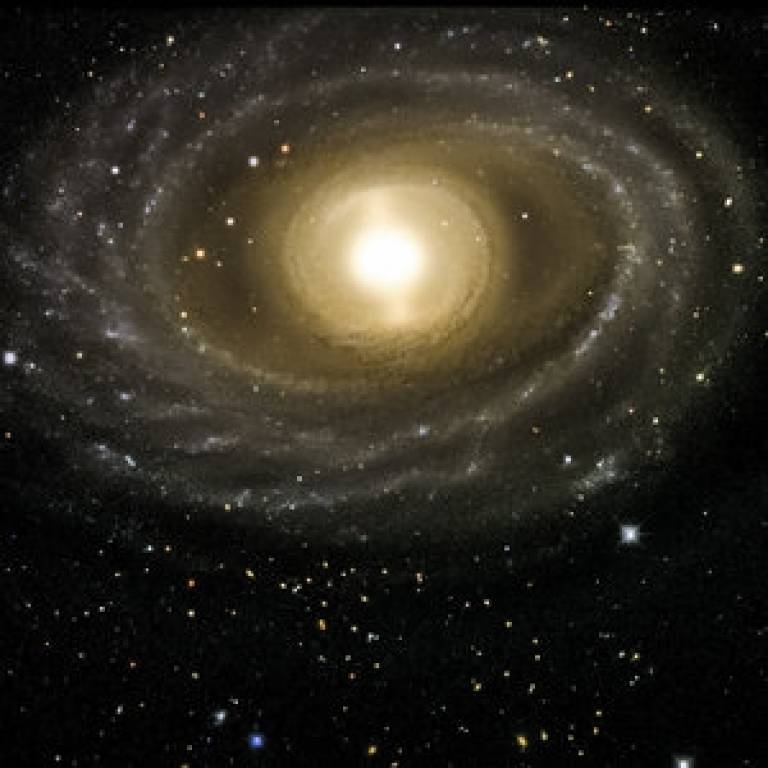Dark Energy Survey kicks off second season cataloguing deep space
18 August 2014
UCL scientists are set to continue investigations into why expansion of the universe is speeding up, having already secured high quality early data.

On 15th August, with its successful first season behind it, the Dark Energy Survey (DES) collaboration, which includes over a dozen researchers from UCL's Astrophysics Group (within Physics & Astronomy), began its second year of mapping the southern sky in unprecedented detail.
Using the Dark Energy Camera, a 570-megapixel imaging device built by DES researchers from over 25 research institutions in six countries and mounted on the Victor M. Blanco telescope in Chile, the Survey's five-year mission is to unravel the fundamental mystery of dark energy and its impact on our universe. Along the way, the survey will take some of the most breathtaking pictures of the cosmos ever captured.
The survey team will use these images to unravel the secrets of dark energy, the mysterious substance that makes up 70 percent of the mass and energy of the universe. Scientists have theorized that the force of dark energy works in opposition to gravity, and is responsible for the accelerating expansion of the universe.
"The DES early data are of high quality and starting the second season is an important milestone to solve the mystery of why the expansion of the universe is speeding up" said Prof. Ofer Lahav (UCL Physics & Astronomy), who heads the DES:UK consortium and co-chairs the DES Science Committee. "DES will count clusters of galaxies, calculate distances to supernovae, measure the bending of light by gravitational lensing and study the pattern of the distribution of galaxy clusters across the universe. Together, these four cosmic probes will tell us if the current model of the universe of valid, or if a new physics is emerging."
The DES early data are of high quality and starting the second season is an important milestone to solve the mystery of why the expansion of the universe is speeding up.
Professor Ofer Lahav
Among the first three early DES papers is a study led by Dr Manda Banerji (UCL Physics & Astronomy) on combining optical data from the Dark Energy Survey with near infra-red data from the VISTA Hemisphere Survey (arXiv:1407.3801). It demonstrates how making additional observations in different colours of light using the VISTA telescope allows more accurate galaxy distance estimates than using DES data alone, as well as helping identify the high-mass galaxies and supermassive black-holes from the combined data.
Commenting on the paper, Dr Banerji said, "The combined DES and VISTA Hemisphere Survey dataset will provide seven different colour measures for over 200 million galaxies by the end of the survey, thus opening up a new observational window into the distant Universe."
UCL was among the founding institutions of DES over ten years ago and has been involved at every level from construction of the camera to analysis of data. Assembly of the DES Optical Corrector of five lenses was led by Prof. Peter Doel and Dr. David Brooks (UCL Physics & Astronomy), with Science & Technology Facilities Council (STFC) funding. Once constructed, it was mounted on the 4-meter Blanco telescope at the Cerro Tololo Inter-American Observatory in the Andes Mountains of Chile.
The camera can see light from more than 100,000 galaxies up to 8 billion light-years away in each crystal-clear digital snapshot. At UCL data are being anlaysed by staff Dr Filipe Abdalla, Prof. Ofer Lahav, Dr Hiranya Peiris and a group of PhD students and Post-doctoral fellows funded by STFC, European Research Council and other sources.
Several more results from DES are expected in the coming months, but in the meantime, the survey team has announced how the public can see the images from the first year, through its photo blog Dark Energy Detectives, and when initial data will be available to researchers worldwide.
Once every two weeks during the survey's second season, a new image or video will be posted to www.darkenergydetectives.org, with an explanation provided by a scientist.
Starting on 1st September, the one-year anniversary of the start of the survey, the data collected by the DES in its first season will become freely available to researchers globally. The data will be hosted by the National Optical Astronomy Observatory.
On the science analysis side, the hundreds of thousands of individual images of the sky taken during the first season are being analyzed by thousands of computers at the National Center for Supercomputing Applications (NCSA) at the University of Illinois at Urbana-Champaign, Fermi National Accelerator Laboratory (Fermilab), and Lawrence Berkeley National Laboratory, and the processed data will also be released in coming months.
The Dark Energy Survey Collaboration comprises more than 300 researchers from 25 institutions in six countries, among them scientist from seven UK universities.
Links
- Professor Ofer Lahav's academic profile on Iris
- Dr Manda Banerji's academic profile on Iris
- UCL Physics & Astronomy
- Dark Energy Survey Collaboration
- Science & Technology Facilities Council (STFC)
- European Research Council (ERC)
Image
- NGC 1398 galaxy taken with the Dark Energy Camera (credit: Dark Energy Survey)
 Close
Close

